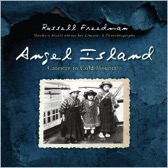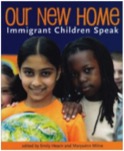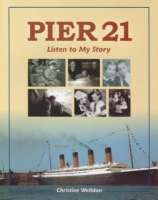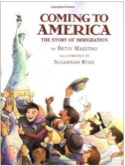by Holly Johnson, The University of Cincinnati
“The land flourished because it was fed from so many sources–because it was nourished by so many cultures and traditions and peoples.”
My grandparents were immigrants. Like many Americans, I can trace my roots to other parts of the world. When I talked with my Norwegian grandmother about her experience of immigrating to the United States, it was one of adventure. Asked by her older brother to make the trans-Atlantic trip in 1920, she responded immediately, and gave her Oslo employer two weeks’ notice. She was 20 years old. The Titanic had sunk eight years earlier (ancient history to a 20 year-old); she was undeterred in her quest to see America. She promised her mother she would visit the United States for only a year—to help her brother get settled—and then return to her family and homeland.
My grandmother never returned to Norway. She married my grandfather, another Norwegian, settled in Minnesota until my father was born, and then moved to Michigan. The rest, they say, is history. And immigration is the history of the United States.
 As a beacon for people across the world, our history includes “waves” of immigration that began in the 1800’s. People from all over the world came to America and continue to reach our shores for a chance at a new life. Books about immigration are often historic, as they add to the story of our nation and our communities. This month, I will discuss some wonderful books about immigration that can be used to flesh out the history our multicultural nation, the North American continent, and to other beacons of hope around the world.
As a beacon for people across the world, our history includes “waves” of immigration that began in the 1800’s. People from all over the world came to America and continue to reach our shores for a chance at a new life. Books about immigration are often historic, as they add to the story of our nation and our communities. This month, I will discuss some wonderful books about immigration that can be used to flesh out the history our multicultural nation, the North American continent, and to other beacons of hope around the world.
 Immigration involves the movement of people into a nation outside their native country. The hope is to settle in the new country as permanent residents and future citizens. Immigrants leave their native countries for any number of reasons, including the hope of a better economic situation, removing themselves from political issues in their native country, reuniting with family, escaping conflict or natural disaster, or because of wanting to change their surroundings.
Immigration involves the movement of people into a nation outside their native country. The hope is to settle in the new country as permanent residents and future citizens. Immigrants leave their native countries for any number of reasons, including the hope of a better economic situation, removing themselves from political issues in their native country, reuniting with family, escaping conflict or natural disaster, or because of wanting to change their surroundings.
 This week, I highlight non-fiction books that address immigration itself or the experiences of immigrating to North America. An older, but familiar book, Coming to America: The Story of Immigration (Maestro, 1994) could be an easy introduction to the topic of immigration. Immigration: The Ultimate Teen Guide (Kleyn, 2011) discusses the myths and realities of immigration along with the history of immigration and issues surrounding it. A great read for anyone who wants to know more than just the media coverage! There is also the wonderful book, Our New Home: Immigrant Children Speak (Hearne & Milne, 2008), which is filled with children’s stories, poetry, and essays about their experiences of Canadian immigration. This book features children’s experiences from countries such as Pakistan, Germany, and Somalia.
This week, I highlight non-fiction books that address immigration itself or the experiences of immigrating to North America. An older, but familiar book, Coming to America: The Story of Immigration (Maestro, 1994) could be an easy introduction to the topic of immigration. Immigration: The Ultimate Teen Guide (Kleyn, 2011) discusses the myths and realities of immigration along with the history of immigration and issues surrounding it. A great read for anyone who wants to know more than just the media coverage! There is also the wonderful book, Our New Home: Immigrant Children Speak (Hearne & Milne, 2008), which is filled with children’s stories, poetry, and essays about their experiences of Canadian immigration. This book features children’s experiences from countries such as Pakistan, Germany, and Somalia.
Then, there are other books about immigration. Most people know about Ellis Island, but what about Angel Island, the entry port on the Pacific shore? Russell Freedman’s (2014) Angel Island: Gateway to Gold Mountain chronicles those from Asia who went through “the other Ellis Island” and the process they underwent as part of their immigration experience. Filled with information Freedman gleaned from letters, memoirs, and information that remained at the facility, he brings to life what those from Japan, Korea, and China experienced as an introduction to their new country between 1892 and 1940.
 And while most of us might think we are familiar with Ellis Island, there is the opportunity to revisit our knowledge with books such as Ellis Island (Aloian, 2014) and Ellis Island (Our Nation’s Pride, Set 2) (Kenney, 2011). And for those who want to extend their knowledge about Canadian immigration, there is Pier 21: Stories from Near and Far (Renaud, 2008), which recounts the history of the large building in Halifax, Nova Scotia in which over one million immigrants began their journey into their new country.
And while most of us might think we are familiar with Ellis Island, there is the opportunity to revisit our knowledge with books such as Ellis Island (Aloian, 2014) and Ellis Island (Our Nation’s Pride, Set 2) (Kenney, 2011). And for those who want to extend their knowledge about Canadian immigration, there is Pier 21: Stories from Near and Far (Renaud, 2008), which recounts the history of the large building in Halifax, Nova Scotia in which over one million immigrants began their journey into their new country.
In addition to these books, there are numerous books for young people to read that address particular cultural groups and their reasons for immigrating to the United States. Young readers who may want to know more about this topic might explore the Immigrants in America series or The American Mosaic series. Other series include the Changing Face of North America books and Children’s True Stories: Migration.
In the following weeks, I will discuss the immigration experience and present books from a variety of perspectives that will delight as well as educate all of us about those who are considered immigrants in our communities.
Journey through Worlds of Words during our open reading hours: Monday-Friday, 9 a.m. to 5 p.m. and Saturday, 9 a.m. to 1 p.m. To view our complete offerings of WOW Currents, please visit archival stream.
- Themes: Holly Johnson
- Descriptors: Books & Resources, WOW Currents

